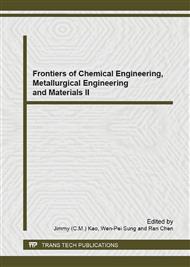[1]
K. Volchek, M. Fingas, M. Hornof, L. Boudreau, L. Duncan and J. Krishnan, Review of Decontamination and Restoration Technologies for Chemical, Biological, and Radiological/Nuclear Counter-terrorism, Manuscript report EE-176, Environmental Protection Service, Environment Canada, Ottawa, ON, (2005).
DOI: 10.1007/1-4020-4924-2_10
Google Scholar
[2]
U.S. Environmental Protection Agency. Compilation of available data on building decontamination alternatives. Office of Research and Development. Washington, DC: National Homeland Security Research Center, (2005).
Google Scholar
[3]
J.V. Rogers, C.L.K. Sabourin, Y.W. Choi, W.R. Richter, D.C. Rudnicki, K.B. Riggs, M.L. Taylor and J. Chang , Decontamination assessment of Bacillus anthracis, Bacillus subtilis, and Geobacillus stearothermophilus spores on indoor surfaces using a hydrogen peroxide gas generator, Journal of Applied Microbiology (2005).
DOI: 10.1111/j.1365-2672.2005.02686.x
Google Scholar
[4]
G. Wagner, D.C. Sorrick and R. Lawrence: Decontamination of VX, GD, and HD on a surface using modified vaporized hydrogen peroxide. Langmuir,(2007)NO. 23, pp.1178-1186.
DOI: 10.1021/la062708i
Google Scholar
[5]
Office of Research and Development National Homeland Security Research Center. Assessment of fumigants for decontamination of surfaces contaminated with chemical warfare agents. U.S. Environment Protection Agency,(2010).
Google Scholar
[6]
M. Andrew. Vaporous Decontamination Methods: Potential Uses and Research Priorities for Chemical and Biological Contamination Control. Australian Defence Science and Technology Organisation, (2006).
Google Scholar
[7]
Information on http: /www. deconsolutions. com/Formulation_pdf_files/AHHP_NDIA03%20(2). pdf.
Google Scholar
[8]
Unger-Bimczok, B. Kottke, V. Hertel. The influence of humidity, hydrogen peroxide concentration, and condensation on the inactivation of Geobacillus stearothermophilus Spores with Hydrogen Peroxide Vapor. Pharm. Innov,(2008) NO. 3, pp.23-133.
DOI: 10.1007/s12247-008-9027-1
Google Scholar
[9]
Jiri Svrcek, Antonin Marhoul, Petr Kacer. The influence of operating conditions on the efficiency of vapor phase hydrogen peroxide in the degradation of 4-(dimethylamino) benzaldehyde. Chemosphere,(2010)NO. 81, pp.617-625.
DOI: 10.1016/j.chemosphere.2010.07.052
Google Scholar
[10]
Beatriz Unger-Bimczok, Thomas Kosian, Volker Kottke, et al. Hydrogen peroxide vapor penetration into small cavities during low temperature decontamination cycles. Pharm Innov,(2011)NO. 6, pp.32-46.
DOI: 10.1007/s12247-011-9097-3
Google Scholar
[11]
Information on http: / www. advancedbarrier. com.
Google Scholar


